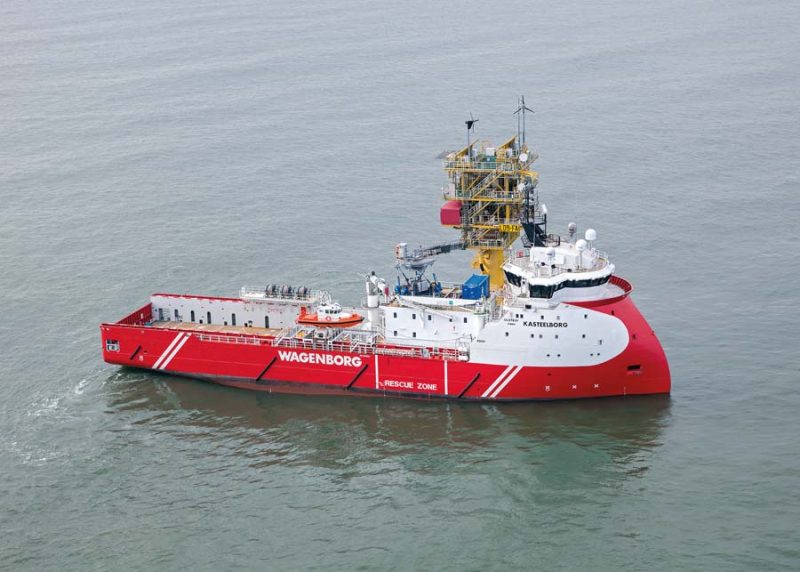
The versatility and adaptability of modern day working vessels will guarantee many a longer active career when demands change in an industry sector for which a ship was primarily built. This feature highlights one such change of career when a modern PSV was converted into a “W2W ERRV,” so a rebuild rather than a newbuild. Back in February 2015 Wagenborg Offshore christened the unique 3,696gt/2015 built ‘Walk-to-Work’ vessel Kroonborg in the port of Delfzijl, The Netherlands. This new concept known as a Service Operating Vessel (SOV) was designed and built to be deployed for a specific Client, Nederlandse Aardolie Maatschappij (NAM), to assist in offshore maintenance activities to unmanned platforms and gas production wells in the Southern North Sea over the coming 10 years. Due to a combination of functions and new techniques the Kroonborg was unique to the industry. The vessel was built for Royal Wagenborg by the Royal Niestern Sander shipyard at Delfzijl, The Netherlands. The 80m long and DP2 equipped ship offers a workshop, storage, accommodation and means of transport for 60 people, including two crews of 20 technicians. These crews work two consecutive weeks on multiple platforms with a motion compensated offshore access system allowing technicians to literally walk to work. Other “Walk to Work” equipped vessels have entered the industry since the Kroonborg and the need for a second such vessel was identified by Royal Wagenborg’s Offshore subdivision in 2017.
Wagenborg Offshore is an international offshore specialist with many years of maritime experience and internationally acquired knowledge in the area of oil and gas related transport disciplines. The company is also a specialist in shallow water projects and has been operating in the Caspian Sea for many years with vessels that were built for the special conditions in that area. The sphere of operations includes Anchor Handing Services, Ice Management Services, Seismic & Ice Survey Services, Offshore & Supply Services, Towage and Accommodation Services. The Parent Company was founded by Egbert Wagenborg, born in 1866, and his interest in the maritime world began as a child and at the age of just 10. In 1898 Mr Wagenborg started out with a two ship fleet under the company name of E. Wagenborg scheepsbevrachter Delfzijl. By 1901 Egbert Wagenborg had a broad portfolio of activities and by 1921 had cargo and ferry services operating, and expanding. From 1925 the marine diesel engine arrived in the shipping industry with the company’s first motor vessel, the Fivel, being purchased in 1927. In 1948 Wagenborg celebrated its 50th anniversary and from 1953 the naming policy of names ending in “borg” became the norm. The company’s centenary year was 1998 and Wagenborg was awarded the designation “Royal.”
From Queen to Castle
The Offshore Industry has endured a tough period with many vessels being laid up around the globe. Numerous elderly examples of these have gone for scrap and some have found a new career. The 6,233gt/2015 bulit Platform Support Vessel Vestland Cygnus was converted to a Special Purpose Ship with a 136 person capacity accommodation block just 6 months after delivery, and C-Beds converted the Seismic Survey Vessel Viking II (built in 1999 as the Veritas Viking II for Eidesvik) into an accommodation and Walk-to-Work vessel in 2016 with capacity for 125 people. The 8,395gt ship was renamed Wind Innovation. The Damen Group also identified the potential of converting idle Platform Support Vessels (PSVs) for new roles in alternative sectors such as aquaculture, shipping and defence. Uses include Container Feeder services, a Logistic Support Vessel, Accommodation Vessels or even a Live Fish Carrier. In 2017 Ulstein published conversion packages for their series of Platform Supply Vessels (PSVs) and one of the first examples to find a new lease of life was an Ulstein PX121 PSV. The hull of the Blue Queen was launched on 3rd November 2014 at the Crist S.A Shipyard in Gdansk, Poland, and towed to Ulstein Verft’s facility in Norway for completion. Delivery took place on 24th February 2015 and the vessel was operated by Golden Energy Offshore Management AS. On 13th November 2017 Wagenborg Offshore was awarded a 6-year contract by Nederlandse Aardolie Maatschappij (NAM) and Shell UK Exploration & Production (Shell UK)) for the provision of a second walk-to-work vessel. NAM and Shell UK work together in a combined business unit on the gas production on the Southern North Sea. The Blue Queen was acquired by Wagenborg Offshore to service this contract with a view to convert her to a Walk-to-Work Emergency Response and Rescue Vessel (W2W ERRV). Such a conversion project enables a company to quickly respond to a business opportunity rather than embark upon a costly and time consuming newbuild process. The duties to fulfill are as a standby and support vessel for inspection and maintenance of the unmanned platforms in both Dutch and British waters. The PX121 has gained excellent feedback from the offshore industry due to a favourable combination of fuel-efficiency and load capacity and the vessel type is particularly suited for a conversion to other types of services and is equipped with a dynamic positioning system Class II and meets the requirements of DNV’s Clean Design. The PX121 is of course of the X-BOW variety, a concept first unveiled to the shipping world in 2005. This bow form offers a gentle displacer, a tapered fore ship shape with a different volume distribution as well as sectional angles, resulting in a wave piercing effect at small wave heights, and also reduces pitching and bow impact loads in bigger seas. When comparing fore ship volumes with more conventional, bulbous bow shapes, the X-BOW has more displacement volume starting from the waterline. Instead of simply rising on the waves and then dropping with tremendous force, the X-BOW is able to absorb the force more consistently across its surface, enabling the ship to remain more stable during poor weather conditions, increasing comfort for passengers and crew alike and because it uses less fuel to get through the waves, it also helps to save energy. The X-BOW produces very little spray, so the deck remains dry behind, a benefit to the working environment at sea. The major benefits of the X-BOW include improved power efficiency, soft entry in waves, very low levels of noise and vibrations, reduced bow impact and slamming plus reduced wave-induced vibrations. It is worth noting here that in winter 2016-17 Wagenborg Offshore added a new accommodation unit to the 1,659gt/2012 built Serkeborg, increasing capacity from 12 to 24 people, including 11 crew members. The ship became a Diving Support Vessel, was renamed Redsborg and the conversion work was undertaken at the Royal Niestern Sander Shipyard, which included a DP2 system, a fire-fighting unit, a four point mooring system, a diving decompression chamber, a moon pool and a crane upgrade to a capacity of 25t at a 10m outreach.
The Blue Queen was repainted into Wagenborg colours at the Ulstein shipyard and departed for her new homeport of Delfzijl, The Netherlands, on 12th December 2017, arriving two days later. The vessel entered the Royal Niestern Sander Shipyard to commence her 12-week conversion programme from which she would emerge a fully operational W2W ERRV. The shipbuilding yard is fully equipped for the engineering and construction of ships up to 14,000dwt and has a product history which includes multipurpose dry cargo vessels, IMO 2 tankers, bulkers, container feeder ships, anchor handling tugs, ice breaking support multipurpose vessels, a maintenance support vessel for the offshore industry (Walk-to-Work equipped) plus, most recently, an open-top multi-purpose ice-classed vessel (the EasyMax design). The yard boasts two floating docks for ships up to 200m long/25m beam plus a 600m long quayside. The yard first opened in 1901 when shipbuilder Berend Niestern and his sons settled in Delfzijl. Twenty years later the brothers Gerhardus and Jacob Sander also began shipbuilding activities in the port. The established Appingedam Shipyard and the Niestern Yard merged in 1970 with the new company being named Appingedam Niestern Delfzijl. Ten years on from this, the facility merged with the Sander yard and became Niestern Sander BV. In May 2001 the Sander shipbuilding and repair company celebrated its centenary and was awarded the Royal title.
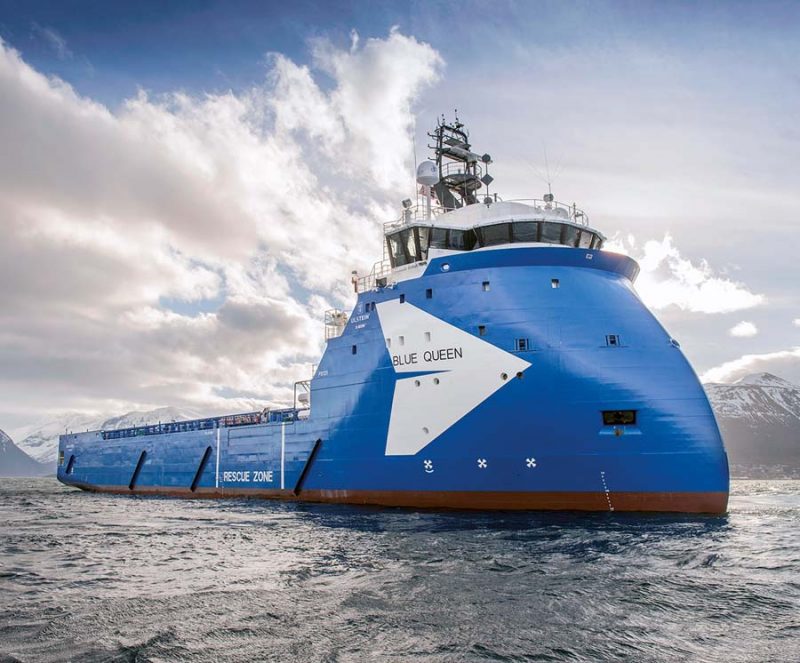
When built, the 3,636gt Blue Queen had a cargo deck with an area of 840m2 (56m long x 15m wide) and a deckload of 2,200t. As is customary with the PX121 design of vessel, the machinery spaces and accommodation areas are located forward. As built, the engine room occupies the Tank Top and Tween Deck levels. The ship is powered by two 1,800rpm/2,350kW 3516C Caterpillar Inc. units and two 1,800rpm/994kW C32 ACERT Caterpillar Inc. units. The Diesel Electric propulsion package drives two 2,200kW Azimuthing AZP 100 CP Rolls-Royce Marine AS units with a 2.8m diameter that are “Azipull” so pull the ship along rather than push. They turn in any direction to provide optimum maneuverability. Two 880kW TT 2200 DP CP Rolls-Royce Marine transverse tunnel thrusters are also installed along with an 880kW UL1201FP retractable Azimuthing Thruster. The latter is deployed to assist the fixed thrusters when operating in Dynamic Positioning (DP2) mode. The service speed is 12 knots. The switchboard and workshop areas are also located in the forward machinery spaces. One level above is the Main Deck that houses the Reception Area, Hospital, Gym, Office, Laundry, ECR and Incinerator/Garbage area. A-Deck contains the AC Room, Day Room, Smokers Lounge, Mess Room, Galley plus the Dry Provisions and Stores Areas. On B Deck above can be found 8 crew and Officer cabins with a further 6 large Captain and Officer cabins/living areas on C-Deck. The Bridge Deck is above this level offering 360 degree visibility. Beneath the working deck aft are 14 tanks for various items including Liquid Mud (1,293m3), Brine (293m3) and Cement (254m3). Other tank capacities aboard include Fresh Water (1,016m3), Fuel Oil (1,461m3) and Ballast Water (1,664.41m3).

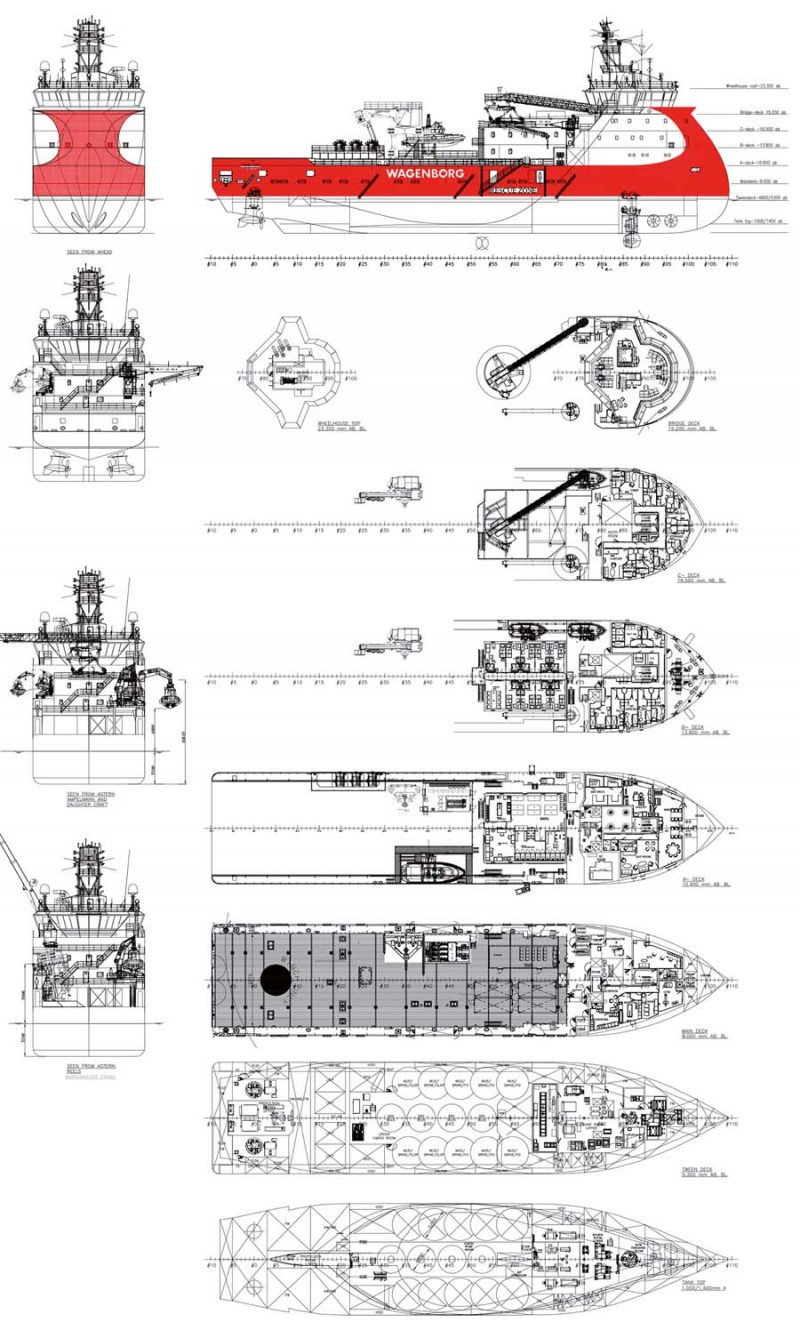
Point of No Return
The Blue Queen was transformed from a PSV to an ERRV when, on 24th January, the floating crane Triton installed the new accommodation unit aboard the ship. The new section was built at the Royal Niestern Sander yard’s fabrication facility and shipped by barge to Delfzijl for installation. The new block offers accommodation facilities for an additional 15 people and enables the walk to work vessel to provide her Emergency Response and rescue capabilities (ERRV). For this specific purpose a recovery area, survivor area, decontamination room and hospital is facilitated. The two-storey accommodation sits on supports fixed to the cargo deck so the lower level of the new superstructure is located at A-Deck height. Located here is the Survivor Decontamination, Survivor Recovery, Survivor Reception, Hospital Treatment and Recovery rooms. At B-Deck level is a Conference Room plus 3 single cabins and 6 twin bed cabins. Located on the starboard side aft of the main superstructure is a knuckle boom shipboard crane with a 3t capacity at an 18m outreach and a 0.5t capacity when the telescopic boom is extended to 21.5m. Atop the new accommodation block is fitted an Ampelmann A27 motion compensated gangway system, which was installed on 7th March 2018. This unit permits offshore crews to be transferred safely from the vessel to unmanned platforms in wave heights up to 3.5m. Details are not widely available but the A-type gangway is shown as being designed to transfer 20 personnel safely and efficiently in only five minutes and move cargo loads of up to 100kg with the KIB cargo basket from vessels to offshore structures. The telescopic length is 25m approx. with a weight of 39t and an on-deck footprint of 6.3m x 7.3m. Immediately aft of the new superstructure section on the port side is located a motion compensated offshore deck crane with a safe lifting capacity ranging between 20t at a 10m outreach and 1.5t at a 32.5m outreach. The aft deck also provides a covered working area, workshops and a warehouse. A Fast Rescue Craft and a Daughter Craft are carried for rescue and maintenance purposes. Since conversion, the 83.40m long, 18.00m beam and 6.68m draught (increased from 6.706m) ship now has an increased gross tonnage of 4,191gt.
Completion & Delivery
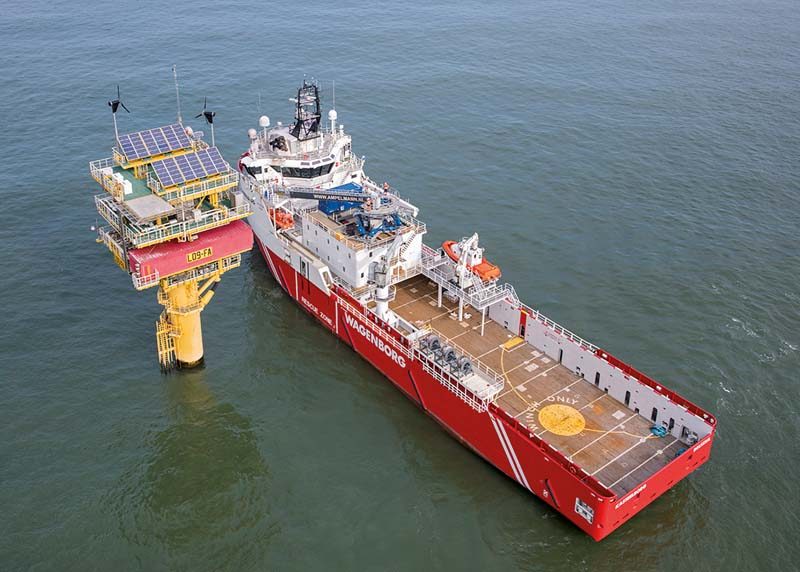
The Kasteelborg was put to work from 7th March 2018, supporting the offshore activities on the southern North Sea under the 6-year contract with the Nederlandse Aardolie Maatschappij and Shell UK Exploration & Production (Shell UK). The newly converted W2W ERRV will undertake inspection and maintenance tasks at the unmanned platforms in both Dutch and British waters. The Kasteelborg will be deployed together with the Kroonborg to maintain dozens of unmanned NAM/Shell UK platforms. The original idea of the newbuild that became the Kroonborg was to have all the major maintenance carried out by one vessel. However, in practice the ship was often used for unscheduled interventions at other platforms. This made it impossible in practice to carry out maintenance according to a long-term planning schedule. The co-operation between the two W2W vessels is a unique combination in the world of offshore maintenance.
TECHNICAL SPECIFICATIONS
(Including Before/After Conversion Data where appropriate)
| Designer: | Ulstein Werft PX121 |
| Contract Date: | 29th January 2014 |
| Keel laying date: | 15th April 2014 |
| Launch date: | 3rd November 2014 |
| Delivery date: | 24th February 2015 |
| Shipyard: | Crist S.A. (Hull Builder)/ Ulstein Verft AS (Outfitter) |
| Hull No.: | 305 |
| Conversion Date: | November 2017-March 2018 |
| Redelivery Date: | 7th March 2018 |
| Ship Type: | Platform Supply Vessel/W2W ERRV |
| Classification (As Built): |
1A1 Offshore service vessel (Supply) Clean(Design) COMF(C-3, V-3) DK(+) DYNPOS(AUTR) E0 HL(2.8) Ice(C) LFL(*) NAUT(OSV(A)) OILREC Recyclable SF |
| Classification (Converted): | Supply vessel – Offshore Support Vessel COMF-NOISE 3, COMF-VIB 3, AUT-UMS (SS), SYS-NEQ-OSV (SS), GREEN PASS PORT, CLEANSHIP SUPER, ICE , DYNAPOS AM/AT R, SDS Owner: Blue Ship Invest AS/Wagenborg Offshore Operations B.V. |
| Operator: | Blue Ship Invest (managed by Golden Energy Offshore Management AS)/ Wagenborg Offshore BV, c/o Wagenborg Kazakhstan BV ,Marktstraat 10, 9934 CK Delfzijl, The Netherlands |
| IMO: | 9732204 |
| Flag: | Norway/The Netherlands |
| Port of Registry: | Ålesund/Delfzijl |
| Gross Tonnage: | 3,636/4,191 |
| Deadweight: | 4,065 |
| Net Tonnage: | 1,295 |
| Length Overall: | 83.40m |
| Length b.p: | 76.50m |
| Beam: | 18.00m |
| Draught: | 6.706m/6.68m |
| Hull Depth (Main Deck): | 8.00m |
| Freeboard: | 1,319mm |
| Main Engines: | 2x 3516C Caterpillar Inc.1,800rpm/2,350kW each. 2×1,800rpm/994kW C32 ACERT Caterpillar Inc. |
| Emergency Generator: | 1 x Scania DI12 62M, 220kW |
| Propulsion Thrusters: | 2x Azimuthing AZP 100 CP Rolls-Royce Marine AS 2,200kW Azipull Units – Propulsion Ulsteinvik. 2.8m diameter propellers |
| Maneuvering Retractable Azimuth Thruster: | 1 x 880kW UL1201FP |
| Transverse Tunnel Thrusters Bow: | 2x 880kW TT 2200 DP CP Rolls-Royce Marine AS – Propulsion Ulsteinvik Anchor Chain Length: 495m |
| Anchor Chain Diameter: | 46mm |
| Service Speed: | 12.00 knots |
| Maximum Speed: | 15.80 knots |
| Deckload: | 2,200t |
| Work/Cargo Deck area: | 840m² – 56 x 15m |
| Deck strength: | 10t/m² aft of #35 – 5t/m² elsewhere |
| Height of cargo rail: | 4.00m |
| Tugger Winches: | 2 x 10 |
| Dynamic Positioning: | DP2 |
| Crew/Personnel Capacity: | 22/37 |
| Crew/Personnel Accommodation: | (As Built) 3 x 1 bed cabins with separate bedroom; 9x single bed cabins; 2x 3 bed cabins & 2 x 2 bed cabin w/common living room and toilet |
| Crew Facilities: | (As Built) 2x Day Rooms/Mess Room/Gymnasium/Hospital/ Reception & Laundry |
| Additional ERRV accom.: | 9 cabins (3 single, 6 double cabins)/Office/Survivor Area/Hospital/Recovery Area/Conference room |
| Deck Equipment: | 1x Motion compensated offshore deck |
| crane: | Lifting capacity: 20t @ 10m/2t @ 32.5m/15t @ 9m/ 1.5t @ 32.5m 1x knuckle boom shipboard crane: 3t capacity @ 18m out reach/0.5t capacity @ 21.5m outreach 1 x Ampelmann motion |
| compensated gangway: | 3m wave height operating range |
| CAPACITIES | |
| Fresh Water: | 1,016m³ |
| Fuel Oil: | 647m³/1,461m³ |
| Ballast Water: | 1,664.41m³ |
| Liquid Mud: | 818m³/1,293m³ |
| Brine: | 818m³/293m³ |
| Methanol: | 155m³ Sg. 4 tanks |
| Baseoil: | 254m³ Sg. 2 tanks |
| Cement: | 254m³ 4 tanks |
| Slop: | 409m³ 4 tanks 150m³ |

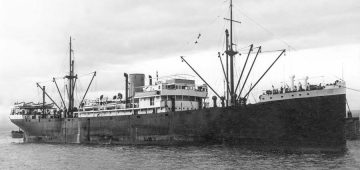



Comments
Sorry, comments are closed for this item